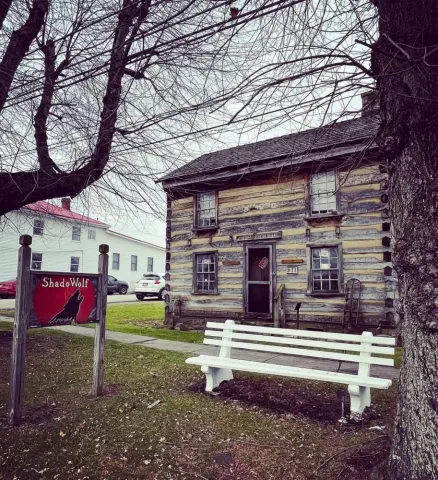Perryopolis
Perryopolis was laid out in 1814 by Samuel Shreve, Dr. Thomas Hersey, Nathan Hersey, and Samuel Bums on land claimed initially by George Washington, consisting of 1,641 acres. The projected town, which featured a central diamond with eight radial streets, was oriented toward new residents and industries. Business and dwelling lots were offered for sale, and dozens of new families moved into the area to settle the new town. Several efforts to further industrialize the area materialized within a year or two of the town plan. They included a glass factory, financed by stock certificates sold to local farmers, many of whom later lost their farms when the factory failed, and the Youghiogheny Bank, which capitalized similarly.
The town plan was much grander than the eventual reality: the layout suited for a much larger, perhaps denser town, with lots at the center initially reserved for facilities characteristic of populous cities, such as an orphanage. Perryopolis never grew into an urban community, and even as a sizable twentieth-century small town, many of the lots toward the center of the town remained largely underdeveloped.
Although Perryopolis has been the market center for Perry Township and surrounding agricultural districts since the town's founding in 1814, the corning of primary coal mining and coke making operations to the area after 1890 led to a wave of construction around the central Washington Diamond to house new and expanded retail stores, restaurants and offices. The increase in population and prosperity that the coal and coke boom brought to Perryopolis Borough led to the opening of new businesses and the founding of new churches. The churches and some businesses were the products of Eastern European immigrants who were attracted to the Perryopolis area by the mines and ovens. Long-time area residents started businesses.
By 1921, Perryopolis had become such a center for the surrounding coal company towns of Star Junction, Whitsett, and Wick Haven that it could support the full-fledged movie and vaudeville theater and variety of other entertainment facilities which the Karolcik Building provided. None of Perryopolis' other commercial structures of the coal and coke era rival the Karolcik Building in terms of sophistication of design or quality of materials. Nearby Dawson, Fayette County, like Perryopolis, did not develop as a coal patch town, and has similar commercial buildings such as the Cochran Bank building at the corner of Main and Railroad Streets. Dawson also had an opera house, which was subsequently used as a Masonic hall.In 1950, Perryopolis Borough was incorporated as a separate municipality. Today, Perryopolis is a center for small industry and a bedroom town for larger towns in the Monongahela valley and Pittsburgh. The central business district retains sufficient vitality to support various retail businesses around the central Washington Diamond, despite competition from a commercial strip along the Route 51 bypass.


